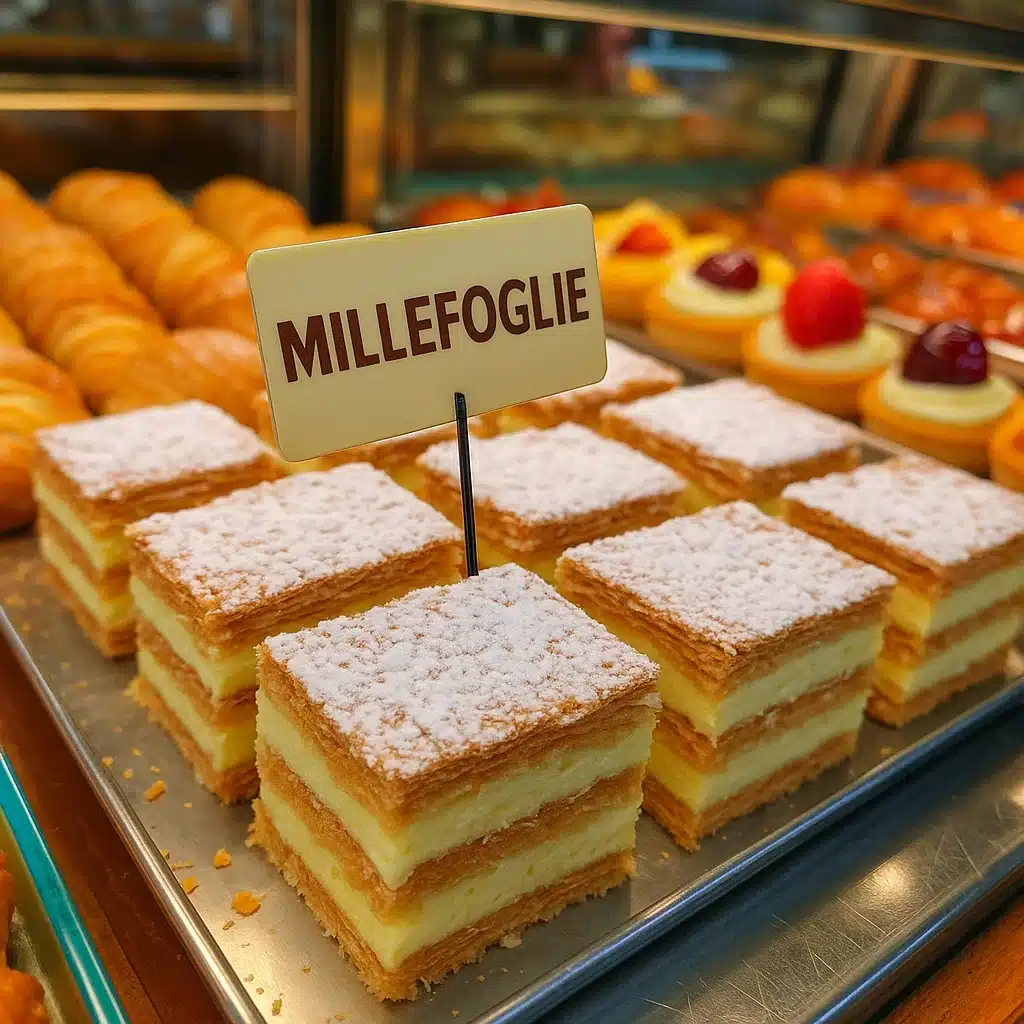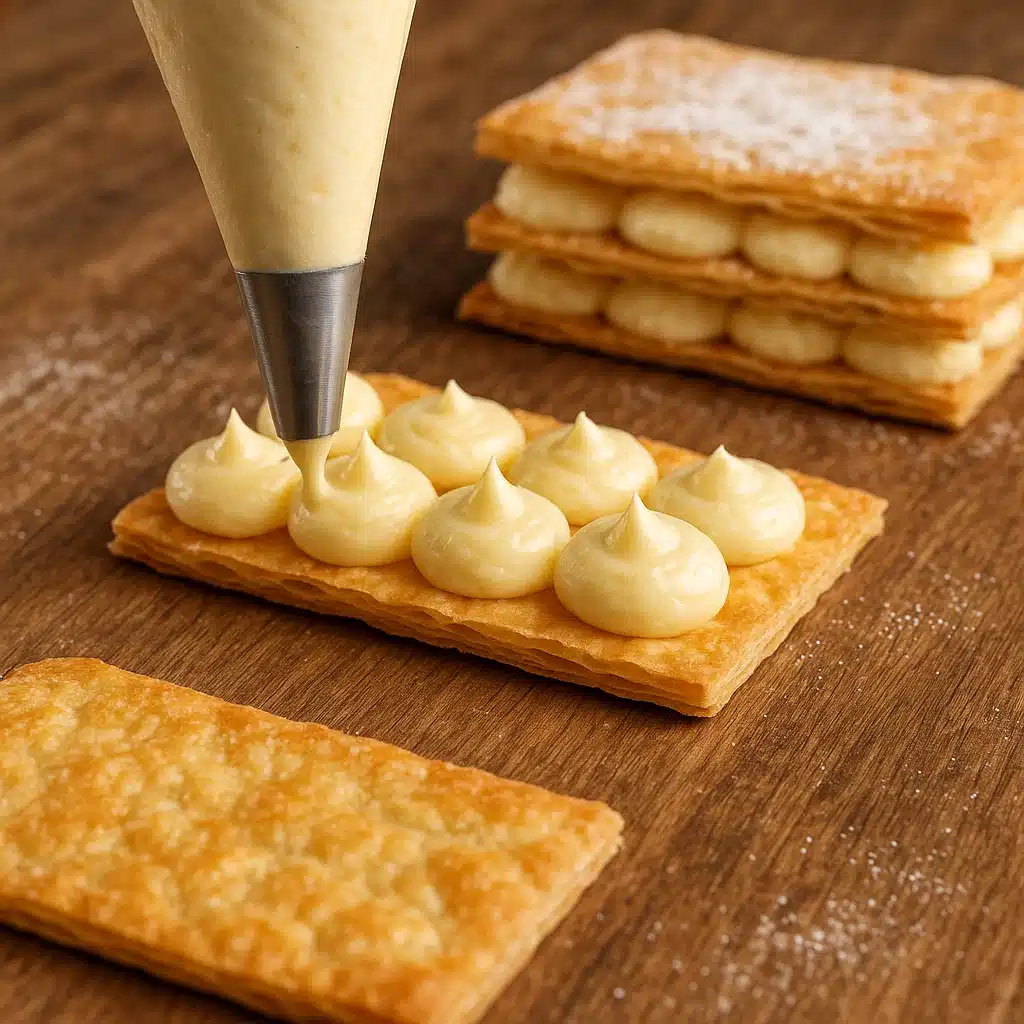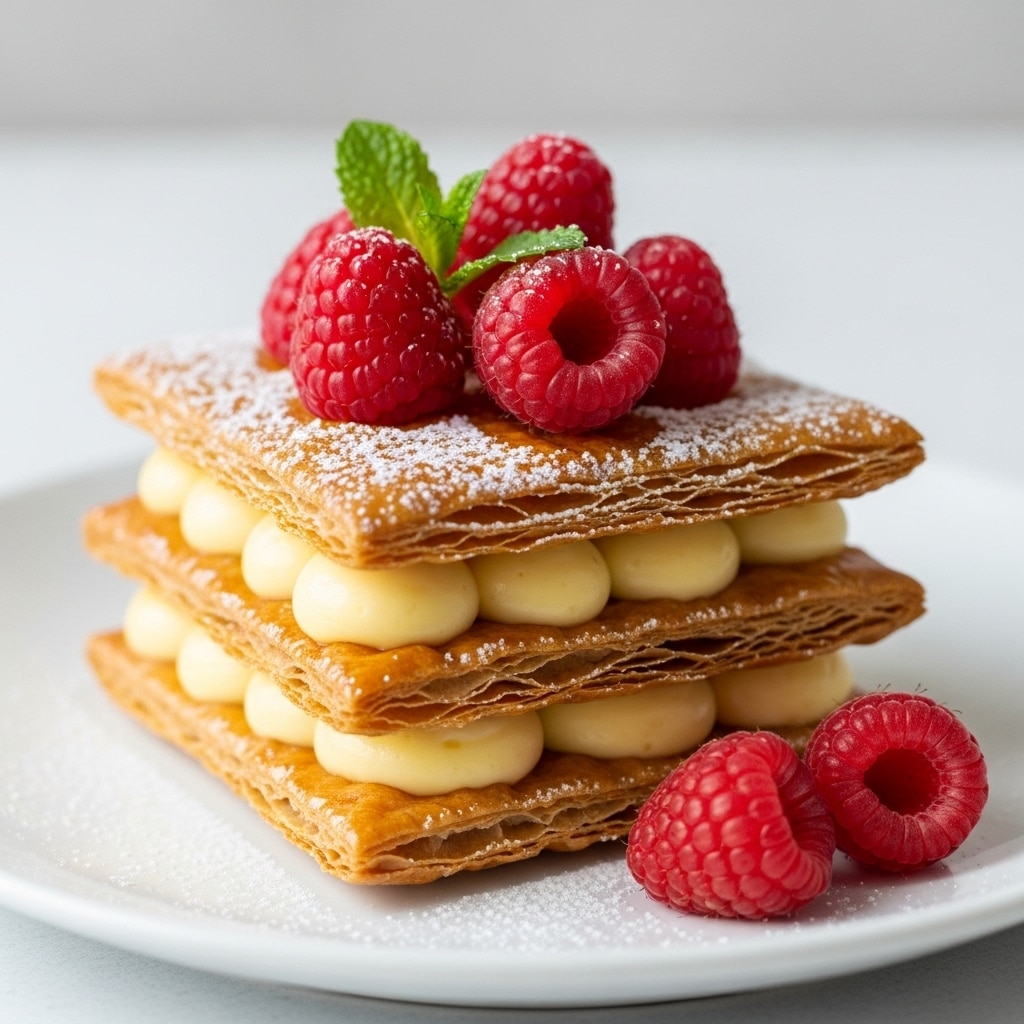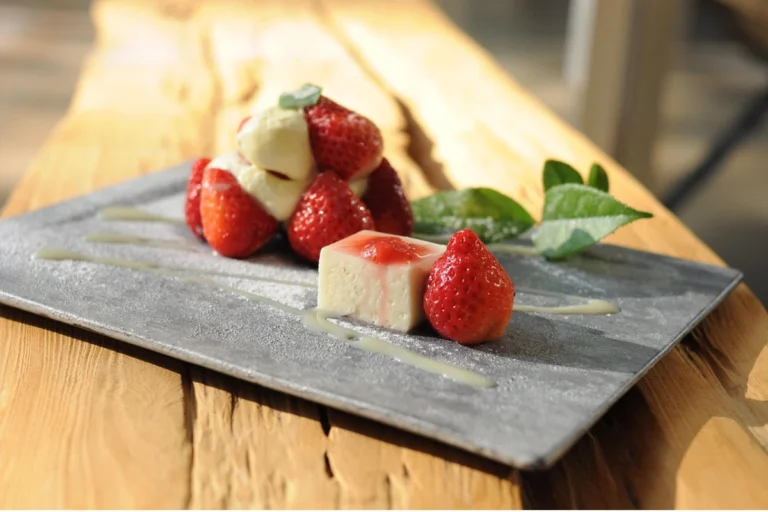Millefoglie – The Best Classic Italian Dessert Recipe Made Easy
Millefoglie is a flaky, creamy Italian dessert that’s as beautiful as it is delicious. Built from crisp layers of puff pastry and filled with luscious custard cream, it offers the perfect balance of texture and flavor. Whether you’re planning a party or simply treating yourself, millefoglie makes a stunning impression without demanding expert baking skills.
In this guide, you’ll discover everything about this classic dessert—its origins, the difference between millefoglie and millefeuille, how to make it step-by-step, and creative flavor variations. We’ll also share storage tips, slicing tricks, and expert pastry secrets. To make the process easier, check out our essential kitchen tools before you get started.
Let’s begin by digging into the roots of millefoglie and what makes it such a beloved Italian classic.
History and Origins of Millefoglie
The Roots of Millefoglie: French or Italian?
Many dessert lovers wonder: is millefoglie Italian or French? The name comes from the French millefeuille, meaning “a thousand leaves,” but Italy has proudly claimed its own version for centuries. During the Renaissance, Italian bakers already used thin dough and creamy fillings to craft early versions of this dessert.
France developed the classic puff pastry technique in the 17th century, and Italy soon adapted it. Italian chefs lightened the dessert, added local flavor twists, and turned it into a festive favorite. Today, millefoglie appears in bakeries across Italy—especially during birthdays, holidays, and weddings.
PrintClassic Millefoglie
A light and flaky Italian dessert made with puff pastry and custard cream, layered and dusted with powdered sugar. Simple yet elegant.
- Prep Time: 20 minutes
- Chill Time: 1 hour
- Cook Time: 25 minutes
- Total Time: 1 hour 45 minutes
- Yield: 6 large, 12 small 1x
- Category: Dessert
- Cuisine: Italian
- Diet: Vegetarian
Ingredients
1 puff pastry sheet (357g), 9×15 inches
2 cups (470 ml) whole milk, hot
3 egg yolks
1/3 cup (65g) sugar + 2 tbsp for pastry
1/4 cup (30g) corn starch
1 tsp vanilla extract
1 1/4 cup (300 ml) whipping cream
Powdered sugar for dusting
Instructions
Bake puff pastry: roll out, prick with a fork, sprinkle with sugar, bake at 375°F for 25 minutes.
Make custard: whisk yolks, sugar, and starch; temper with hot milk; cook until thickened.
Chill custard. Whip cream and fold into custard.
Assemble in 3 layers, piping cream between each. Top with powdered sugar. Chill, slice, and serve.
Notes
Nutrition facts are estimates and may vary based on ingredients used, portion sizes, and preparation methods
Nutrition
- Serving Size: 1
- Calories: 285
- Sugar: 12g
- Sodium: 90mg
- Fat: 18g
- Saturated Fat: 11g
- Unsaturated Fat: 7g
- Carbohydrates: 27g
- Fiber: 0.5g
- Protein: 4g
- Cholesterol: 85mg
Keywords: millefoglie, Italian dessert, puff pastry dessert, custard cream pastry, mille feuille, layered pastry, easy millefoglie recipe, homemade Italian pastry
Let’s connect! Follow me for more Joylicious Recipes: Facebook, Instagram, Pinterest
Millefoglie vs. Millefeuille: Understanding the Cultural Debate
Although the structure of these two desserts is similar, the presentation and fillings differ. The French millefeuille often comes with pastry cream and a shiny glaze topped with chocolate lines. Millefoglie keeps things simple with powdered sugar and a custard cream that’s sometimes folded with whipped cream.
Here’s a helpful comparison:
| Feature | Millefeuille (France) | Millefoglie (Italy) |
|---|---|---|
| Topping | Glazed icing with chocolate | Powdered sugar |
| Filling | Thick pastry cream | Custard cream + whipped cream |
| Flavor Additions | Vanilla, chocolate | Lemon zest, liqueur, or fresh berries |
| Texture Preference | Rich, dense | Lighter, airier |
Each version has its own charm. Millefeuille brings a polished, pastry-shop vibe, while millefoglie leans into comforting textures and flavors that remind you of homemade goodness.
Don’t miss our guide on how to elevate your bakes with homemade cinnamon butter—a perfect complement to buttery puff pastry.
What Is Millefoglie?
Definition and Translation of Millefoglie
Millefoglie (pronounced meel-leh-FOHL-yeh) is an Italian dessert made from layers of puff pastry and creamy custard. The name translates to “a thousand leaves” in English—a nod to the delicate, flaky texture of the pastry. Each bite offers a light crunch followed by a smooth, sweet filling. It’s no wonder this treat has remained a favorite across generations.
In pastry terms, millefoglie belongs to a family of layered desserts. Though similar to the French millefeuille, it features key Italian elements like lighter cream and a simple powdered sugar topping. It’s elegant without being complicated, and it can be served at casual meals or formal events.
You can find millefoglie in bakeries throughout Italy, but making it at home is easier than it looks—and so worth it.
What Makes Millefoglie Unique in Texture and Taste
What sets millefoglie apart? It’s all about the contrast. The crisp, buttery pastry layers create a satisfying crunch, while the custard or cream brings soft, rich sweetness. Together, they form a dessert that feels light but still indulgent.
Unlike heavier cakes or dense puddings, millefoglie delivers flavor without overwhelming the palate. It’s often served chilled, which enhances the freshness of the cream and the crispness of the pastry. Some variations include fruit, chocolate, or liqueur, but the classic version sticks to simplicity: pastry, cream, and a dusting of powdered sugar.
Here’s a quick snapshot of its signature traits:
| Characteristic | Millefoglie Qualities |
|---|---|
| Texture | Crisp, flaky pastry and soft, creamy filling |
| Flavor | Sweet, delicate, slightly buttery |
| Temperature | Best served chilled |
| Appearance | Elegant layers, dusted with powdered sugar |
Discover great ideas like this one and explore tools to perfect your puff pastry layers in our Kitchen Tools section.
Millefoglie’s texture isn’t just about taste—it also impacts how the dessert is sliced and served. In the next part, we’ll walk through the ingredients you need and how to make it from scratch using just a few everyday items.
Ingredients Breakdown
Key Components of Millefoglie: Puff Pastry, Custard, and More
Making millefoglie doesn’t require a long list of fancy ingredients. Chances are, your kitchen is already stocked with most of these basic ingredients. The magic comes from the balance between light puff pastry and smooth cream filling.
Here’s what you’ll need for a classic homemade millefoglie:
| Ingredient | Amount | Notes |
|---|---|---|
| Puff pastry sheet | 1 (357g), 9×15 inches | Store-bought or homemade works |
| Whole milk (hot) | 2 cups (470ml) | Used to make the custard cream |
| Egg yolks | 3 | Provides richness and helps thicken cream |
| Sugar | 1/3 cup (65g) + 2 tbsp | Sweetens both pastry and custard |
| Corn starch (or all-purpose flour) | 1/4 cup (30g) | Thickens the custard |
| Vanilla extract | 1 teaspoon | Adds flavor to the cream |
| Whipping cream | 1 1/4 cups (300ml) | Folded into the custard for added lightness |
| Powdered sugar | To dust | Finishing touch for that classic look |
That’s it! No complex additives. Just simple ingredients that, when combined right, turn into an elegant, crowd-pleasing dessert.
Ingredient Sourcing Tips for Authentic Flavor
For the best millefoglie, ingredient quality matters. Here’s how to level up your dessert without complicating the process:
- Use high-fat puff pastry: If buying frozen, choose an all-butter brand. It delivers flakier texture and better taste.
- Heat the milk gently: Don’t let it boil. Warm milk blends more smoothly into the custard base.
- Go for real vanilla extract: Skip the artificial stuff. Real vanilla gives the cream a warm, floral flavor.
- Fresh eggs are a must: They create smoother, more stable custard.
Many bakers try shortcuts, like instant pudding, but authentic millefoglie shines with fresh, real ingredients. The taste difference is clear in every bite.
Don’t miss our guide on kitchen essentials for cream-based recipes—perfect for making custard smoother and faster.
Now that you know what goes into it, you’re ready to start baking. In the next part, we’ll show you exactly how to prepare each layer and build a millefoglie that looks and tastes like it came from an Italian bakery.

How to Make Traditional Millefoglie at Home
Step-by-Step Guide with Timing and Prep Tips
You don’t need to be a pastry chef to make millefoglie. With the right steps, you can create this stunning dessert in your own kitchen. Here’s a simple breakdown of the process—from pastry prep to final assembly.
1. Bake the Puff Pastry
Start by preheating your oven to 375°F (190°C).
- Unroll one puff pastry sheet (357g), measuring about 9×15 inches, onto a baking tray lined with parchment paper.
- Use a fork to poke holes all over the pastry so it doesn’t puff up while baking.
- Sprinkle 2 tablespoons of sugar evenly on top.
- Cover with another sheet of parchment paper and place a second baking tray on top to weigh it down.
- Bake for 20 minutes, then remove the top tray and paper.
- Continue baking for another 5 minutes, or until the pastry turns golden and crisp to the touch.
- Let the pastry cool completely.
Tip: Don’t skip the sugar—it caramelizes lightly for extra flavor and crunch.
2. Make the Custard Cream
While the pastry cools, heat 2 cups (470ml) of whole milk until hot (not boiling). A small saucepan or microwave works fine.
In a separate medium pan:
- Whisk together 3 egg yolks, 1/3 cup (65g) sugar, and 1/4 cup (30g) corn starch until light and smooth.
- Gradually pour in a bit of the warm milk, whisking nonstop to gently warm the egg mixture and avoid scrambling.
- Pour in the rest of the milk and whisk again.
- Place the pan over medium heat and stir continuously until the mixture thickens into a smooth custard.
- When it begins to bubble, lower the heat, add 1 tsp vanilla extract, and cook for 1–2 more minutes.
- Transfer the custard to a glass bowl, cover it with plastic wrap touching the surface, and cool to room temperature. Then refrigerate.
3. Prepare the Whipped Cream Filling
- Whip 1 1/4 cups (300ml) of whipping cream until stiff peaks form.
- Once the custard is completely chilled, fold the whipped cream into the custard gently.
- Divide the finished cream into two piping bags and refrigerate for at least 30 minutes before using.
Common Mistakes to Avoid When Baking Puff Pastry
Even with a simple recipe, a few common mistakes can ruin your millefoglie. Here’s how to avoid them:
- Don’t skip pricking the pastry – It helps avoid puffing too high.
- Always weigh it down – Use another tray or baking weights so layers stay flat.
- Let layers cool fully before assembling – Warm pastry melts cream.
- Avoid overbaking – Too much time in the oven makes it hard to cut.
Taking the time to follow each step ensures that your millefoglie looks impressive and tastes just as good.
Discover more pastry tips in our complete baking comfort food guide.
In the next part, you’ll learn how to master the custard filling so it holds its shape and flavor every time.
Crafting the Perfect Custard Cream Filling
Traditional Custard vs. Modern Cream Alternatives
The custard cream is the heart of any good millefoglie. It brings that rich, smooth texture that pairs perfectly with crisp pastry. While classic versions use a traditional egg-based custard, modern bakers sometimes lighten it with whipped cream or try alternatives like mascarpone or pastry cream from a box.
But if you want flavor and structure, homemade custard wins every time.
Here’s how it compares:
| Feature | Traditional Custard | Store-Bought/Alternative Creams |
|---|---|---|
| Taste | Rich, vanilla-forward | Often bland or overly sweet |
| Texture | Smooth, thick, and stable | Can be runny or too airy |
| Ingredients | Milk, eggs, sugar, starch | Additives or artificial thickeners |
| Performance in layers | Holds shape between pastry well | May leak or collapse under pressure |
Traditional custard not only tastes better but also holds up during slicing, which is key for a clean, elegant presentation.
Tips for Achieving Smooth, Stable Custard
Getting the texture just right can feel tricky—but it’s totally doable if you follow a few simple rules:
- Whisk before the heat hits: Make sure eggs, sugar, and starch are smooth before adding warm milk. This helps avoid lumps.
- Warm the milk gently: Don’t boil. Just heat it until it’s hot to the touch, so it blends easily into the egg mixture.
- Add milk gradually: Slowly pour in a small amount first while whisking to bring the egg mix up to temperature (this step is called tempering).
- Keep the mixture moving over the heat—stir it continuously until it thickens to a smooth consistency. Don’t walk away—it can scorch fast.
- Use low heat near the end: After it bubbles, reduce the flame and cook for another minute or two until you reach the desired thickness.
- Cover the surface with plastic wrap: Press the wrap directly onto the custard to prevent a skin from forming.
Once chilled, this custard can be folded with whipped cream for a lighter texture—or used on its own for a more traditional millefoglie experience.
Don’t miss our tip-packed guide on how to master creamy, rich textures in savory dishes too—a great skill-builder for both sweet and savory recipes.
This smooth, stable cream will make your millefoglie stand tall and slice clean. In the next part, we’ll walk through assembling your dessert and adding that final elegant touch.
Assembling and Serving Millefoglie
Layering Technique for Aesthetic and Taste
Assembling millefoglie might look intimidating, but it’s all about patience and precision. By the time your puff pastry and custard cream are ready, you’ve already done most of the hard work. Now it’s time to turn those components into a showstopping dessert.
Here’s how to layer like a pro:
- Trim the puff pastry: Once cooled, slice the pastry sheet into three equal sections, about 5×9 inches each. A serrated knife works best for clean cuts.
- Pipe the first layer: Take your chilled custard cream from the fridge and cut a small opening (about ¼ inch) from one piping bag. Pipe evenly spaced dots or stripes across the first layer of pastry.
- Add the second layer: Place the next pastry piece on top. Repeat the piping with the second half of your cream using the second piping bag.
- Top it off: Lay the final puff pastry on top, gently pressing down to keep the layers stable.
Sprinkle a generous layer of powdered sugar over the top to complete the look. It’s the final touch that gives millefoglie its iconic, elegant finish.

Optional touch: Add fresh berries or shaved chocolate on top for a festive feel.
Looking for inspiration? Try these dessert presentation ideas that add color and style to any dish.
Cutting and Presentation Tricks for Serving Success
One of the biggest challenges with millefoglie is slicing it cleanly without crushing the layers. Here’s how to get restaurant-quality slices at home:
- Chill before cutting: After assembling, refrigerate the millefoglie for at least 30 minutes. This firms up the cream.
- Use a serrated knife: Gently saw through the pastry layers without applying too much pressure.
- Wipe between cuts: Clean your knife after each slice to avoid smearing cream.
- Cut to serve: Slice into 6 large pieces (about 5×1.5 inches) or 12 smaller ones for bite-size portions.
To serve, place slices flat on a dessert plate and garnish with a fresh mint leaf or powdered sugar dusting.
Don’t miss our go-to method for plating beautiful pastries in our dessert styling guide.
With a little practice, your millefoglie will look just as good as it tastes—and better than store-bought versions.
Millefoglie Variations Across Regions
Millefoglie alla Crema, With Berries, or Nutella Versions
While the classic millefoglie sticks to custard cream and puff pastry, Italian bakers love experimenting. Regional and personal twists make this dessert even more exciting.
One of the most popular takes is millefoglie alla crema, which uses a rich vanilla custard or a blend of pastry cream and whipped cream. This version keeps things traditional, but with a fluffier finish.
If you’re looking to dress it up, try:
- Berry millefoglie – Add fresh strawberries, raspberries, or blueberries between layers.
- Chocolate or Nutella millefoglie – Swirl Nutella into the cream or drizzle it over the top.
- Lemon zest – For a brighter flavor, mix in a touch of zest with the custard.
- Espresso-soaked layers – Brush pastry layers with espresso for a tiramisu-inspired twist.
Each version adds something new, but all stay true to the dessert’s roots: crisp pastry, creamy filling, and simple elegance.

Check out our twist on fruit and cream in this mango panna cotta recipe—a perfect summer companion to millefoglie.
Seasonal and Festive Millefoglie Twists
Millefoglie also makes a stunning holiday or seasonal dessert. With just a few tweaks, you can adapt it for any occasion:
| Season or Event | Twist Idea |
|---|---|
| Christmas | Add cinnamon, nutmeg, or crushed peppermint |
| Valentine’s Day | Use heart-shaped pastry layers + berry cream |
| Spring brunch | Decorate with edible flowers and lemon cream |
| Fall dessert table | Fold pumpkin puree or spice into the custard |
| Birthdays & Weddings | Stack tall with multiple layers and fruit |
Many Italian families prepare millefoglie as a birthday cake alternative—it’s lighter, less sugary, and just as beautiful. You can even write messages on the top with melted chocolate.
Looking for more festive dessert inspiration? Don’t miss our guide to creative cake bars—ideal for crowds and easy slicing.
With millefoglie, the possibilities are endless. Keep the basics the same, but let your creativity take over when it comes to flavor and presentation.
Storing and Preserving Millefoglie
How Long Does Millefoglie Last?
Millefoglie is at its best the day it’s made. The contrast between crisp pastry and creamy filling creates that perfect bite. But if you’ve got leftovers—or want to prep ahead—you can still enjoy it for a few days with the right care.
In the fridge, millefoglie lasts about 2 to 3 days. After that, the puff pastry starts to soften as it absorbs moisture from the cream. It’s still tasty, just not as crisp.
To keep that signature texture as long as possible, store millefoglie in an airtight container. Avoid wrapping it directly in plastic wrap, which traps moisture and can make the layers soggy.
Tip: If you’re serving millefoglie for a party, prep the pastry and cream in advance, but assemble it just before serving. This keeps everything fresh and crisp.
Refrigeration, Freezing, and Reheating Tips
Refrigeration is your best bet. Place your assembled millefoglie in a cake box or shallow container with a lid. This prevents the cream from drying out and keeps odors from the fridge away from your dessert.
Freezing millefoglie isn’t ideal, but it’s possible—especially if you freeze only the puff pastry layers. Here’s how:
- Freeze unfilled puff pastry: Bake and cool the pastry sheets. Wrap them in parchment, then place in a freezer bag. They’ll stay fresh for up to 1 month.
- Avoid freezing cream-filled millefoglie: The custard can separate when thawed, turning grainy or watery.
Reheating isn’t recommended for assembled millefoglie. Warming it will melt the cream and ruin the layers. If you’ve frozen puff pastry only, you can re-crisp it in a low oven for a few minutes before assembling.
Looking to master storage-friendly desserts too? Don’t miss our ultimate guide to make-ahead casseroles that stay perfect even after chilling.
The key to preserving millefoglie is simple: protect it from moisture and air, and serve it fresh when possible. If you want to enjoy it at its peak, make it the same day—or store each component separately and assemble when ready.
Millefoglie in Italian Culture
Millefoglie in Celebrations, Weddings, and Birthdays
In Italy, millefoglie isn’t just dessert—it’s tradition. You’ll find it at birthdays, baptisms, anniversaries, and especially weddings. Many Italians choose millefoglie over a classic sponge cake for big events because it feels lighter, fresher, and more refined.
Bakeries across the country offer large-format millefoglie cakes that can be customized with fresh fruit, chocolate drizzle, or names written in icing. Some are even stacked into multi-layer towers for weddings, often filled with chantilly cream and topped with seasonal berries.
Fun fact: In some regions of Northern Italy, millefoglie is called Diplomatico, especially when layered with sponge cake in between the pastry.
What makes millefoglie so popular at events? It’s elegant, but not over-the-top. It looks impressive on a dessert table, but the ingredients stay humble. And most of all, it’s easy to share.
Don’t miss our Italian-inspired crowd-pleaser, oven-fried chicken with a homemade twist—a great savory balance to any dessert.
Regional Significance and Local Bakery Traditions
Each region in Italy has its own take on millefoglie. In the north, you’ll find versions layered with zabaglione or mascarpone. In the south, many bakeries add a splash of local liqueur to the cream for a richer taste.
Local pastry shops (pasticcerie) often make millefoglie daily, selling them by the slice or as small rectangular pastries. You’ll also see single-serve versions in cafés, usually served with an espresso or a sweet wine like Vin Santo.
In Sicily, millefoglie sometimes blends into local favorites like cannoli cream versions or pistachio-infused custards. In Rome, it’s a birthday essential, often topped with a candle and a heavy sprinkle of powdered sugar.
Though it started as a luxury item centuries ago, today millefoglie is a dessert for everyone—fancy enough for weddings, but simple enough for Sunday lunch.
Explore another Italian dessert twist in our easy coconut cream pie recipe—a smooth, rich finish to any meal.
Frequently Asked Questions
Almost! Both desserts share the same foundation—puff pastry and cream layers. The key difference is regional: millefeuille is French and often topped with icing, while millefoglie is Italian, usually dusted with powdered sugar and filled with lighter, whipped custard.
Millefoglie is made from thin layers of baked puff pastry and a creamy filling—usually custard, sometimes folded with whipped cream. The top is dusted with powdered sugar. Other variations may feature fresh fruit, chocolate swirls, or a splash of liqueur to enhance the flavor.
It’s pronounced “meel-leh-FOHL-yeh” in English. The word means “a thousand leaves” in Italian, referring to the many layers of flaky pastry.
Millefoglie tastes light, creamy, and buttery. The contrast between the crisp pastry and smooth filling creates a perfect balance. It’s sweet, but not too rich—ideal for those who enjoy desserts with texture and elegance.
The exact origin is debated. The technique of layering dough started in France, but Italians adapted it centuries ago. Today’s millefoglie is a beloved Italian version of the French millefeuille, with its own flavors and traditions.
Originating in France, millefeuille is known for its glossy icing and dense pastry cream filling. Millefoglie is the Italian version, lighter in texture and usually topped with powdered sugar. Both are delicious, but millefoglie feels less heavy and more casual.
Conclusion
Millefoglie is more than just a dessert—it’s a celebration of contrast, texture, and flavor. From its flaky, buttery pastry layers to the smooth, sweet custard cream inside, every bite feels like a moment worth savoring. Whether you’re making it for a birthday, a holiday, or just because, millefoglie adds elegance without the stress.
We’ve covered everything you need—from its history and ingredients to step-by-step prep, assembly, and even creative regional twists. By now, you know that millefoglie is not only easy to make but also flexible enough to match any occasion.
What makes it so special? It’s the balance—crispy and creamy, simple yet impressive. After your first bite, you’ll find yourself coming back to it time and time again. And again.
Looking for more simple, crowd-pleasing desserts? Don’t miss our easy lemon blueberry bread—it’s just as refreshing and perfect for any season.
So roll up your sleeves, grab that puff pastry, and bring this timeless Italian dessert into your home. Millefoglie might just become your new go-to sweet treat.








